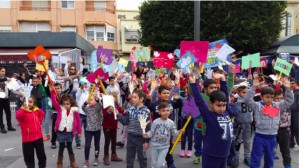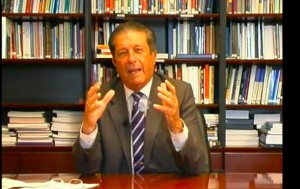. SUSTAINABLE DEVELOPMENT .
an article by Ryan Rappa and Irene Pañeda Fernández, Huffington Post (Reprinted under terms of fair use)
With Greece’s newly elected ruling party, Syriza, bringing international attention to the damage wrought by Troika-imposed austerity, similarly situated parties have been gaining traction all over Europe. Most significant at the moment: the ascension of Podemos in Spain.

Click on photo to enlarge
Hardly one year old, Podemos is already vying for the top spot in Spanish polls. This precocious party vows to throw Spain’s weight behind the tug-of-war Greece is already having with the European Union, further testing the limits of Eurozone coherence.
In short, the EU is facing a moment of truth. Its response to Podemos could validate or vitiate it for years to come.
Podemos’ Past and Present
Podemos, like Syriza, rose out of widespread frustration with fiscal austerity, endemic corruption, and the failure of longstanding political parties to do anything about it. After 2008, faced with upwards of 20 percent unemployment and not-all-that-much public debt, so-called debtor states like Spain were sold the pernicious fiction that they had to cut government spending in order to rein in debt and restore economic growth. Spain’s creditors, especially the “Troika” (the EC, ECB, and IMF), insisted on this austerity, and Spain’s leadership complied, only to see the employment and debt situation deteriorate further.
Ideologically rooted in the 2011 “15-M” anti-austerity movement (a forerunner of Occupy Wall Street), Podemos presented its first party platform in January 2014. Since then, Podemos has won seats in the European Parliament, Spanish regional legislatures, and is a serious contender in Spain’s upcoming general election.
In domestic politics, Podemos promises to increase democratic accountability and transparency – and its ideas are generally sound. They include keeping an up-to-date online account of government finances, imposing term limits and earnings caps on elected officials, and providing for recall elections, initiable by any citizen with enough signatures on a petition.
If elected at the national level, it will be interesting to see how Podemos follows through on these pledges. It has already faltered on the beta version of its first promise, providing up-to-date records of its own party finances.
As for economic policy, Podemos has mixed a few solid proposals with several unkeepable promises. Pablo Iglesias, the de facto leader of Podemos, now finds himself backpedaling on many of these, into vague middle-ground he used to lambaste opponents for occupying.
But who can blame him? It’s not his ideas per se that are (or were) untenable; it’s the ideas in relation to the prevailing institutional setup in Europe. Spain, like Greece, is caught between a rock and a hard place.
The (Il)logic of Europe
It would make sense to let Spain restructure or cancel some of its debt, and put an end to austerity, just as it would make sense to have tighter fiscal union for the long-term viability of the Eurozone. Austerity has clearly failed to relieve economic hardship, and even to meaningfully reduce indebtedness.
(continued into discussion on right side of this page)
Movements against governmental fiscal austerity, are they part of the global movement for a culture of peace?
Readers’ comments are invited on this question.
(continuation of article from left side of page:)
However, the powers that be (Germany, France) have strong incentives to cede only the bare minimum of fiscal sovereignty necessary to keep the Eurozone intact. Simply put, Germans (and other relatively well-off Europeans) have mixed feelings about subsidizing other countries’ debts, and they’re going to explore every possible way to maintain the Euro while minimizing fiscal union, suffering southerners be damned. This means — Mr. Iglesias is quickly realizing — that Podemos can’t hope to fund all of its initial proposals (improved health benefits, education, pensions, salaries, etc.) without defaulting on some of Spain’s debt, or leaving the Eurozone — both of which are pyrrhic scenarios.
The best Spain can hope for, in all likelihood, is a Greece-like compromise. And this isn’t necessarily so bad, all things considered. If Podemos comes to power, the EU will probably give Spain more pecuniary wiggle room, in exchange for a clear plan detailing how Spain will still make good on its debts.
EU decision-makers, trying to balance their short-term political survival against Europe’s longer-term wellbeing, should concede enough to ensure that Spain (not to mention the entire Eurozone) can maintain positive growth and inflation. This is the only way to take control of debt and salvage the Euro in the long run. Podemos will certainly push things in this direction, Germans be damned.
On the other hand, if decision-makers bow to parochial interests and short-termism, Spain and Europe will suffer for it. Continued austerity, at the unnecessary expense of growth, threatens to undermine the entire European project. Anti-EU movements in France, Italy, and Britain are gaining traction like never before.
What Podemos Can Do
Europe’s vicissitudes notwithstanding, an empowered Podemos could go ahead with its other, relatively affordable economic reforms (which could, in turn, help fund the rest of its program). These include raising taxes on the wealthiest Spaniards, cracking down on tax evasion, and restoring competitiveness to Spanish industry.
Plans for the latter include shaking up oligopolies, electricity being perhaps the most stagnant. Currently, over 80 percent of Spain’s electricity is generated and sold by just five companies. These five make double the profits of their European counterparts, and the average electricity bill in Spain has nearly doubled over the last ten years, making Spain’s electricity the most expensive on the continent. The potential savings for consumers in this and other sectors are enormous, and could easily translate into more productive forms of spending throughout the economy.
What allowed this oligopoly to form, in part, is Spain’s sclerotic and considerably corrupt two-party system — which Podemos is also poised to shake up. Since the advent of Podemos, a number of other parties and grassroots movements have come to the fore, auguring increased accountability throughout Spanish politics (whatever the outcome of upcoming elections).
Finally, even if Pablo Iglesias never makes it to La Moncloa (Spain’s White House), Podemos and the other descendants of “15-M” should keep railing against the status quo. Whatever the results of this autumn’s general election, they will be a force in Spanish politics, drawing the entire political spectrum toward their policy goals. The draw might be slight, but it could still be significant. There’s a thin line between a unified Europe and a fragmented, dysfunctional one.

